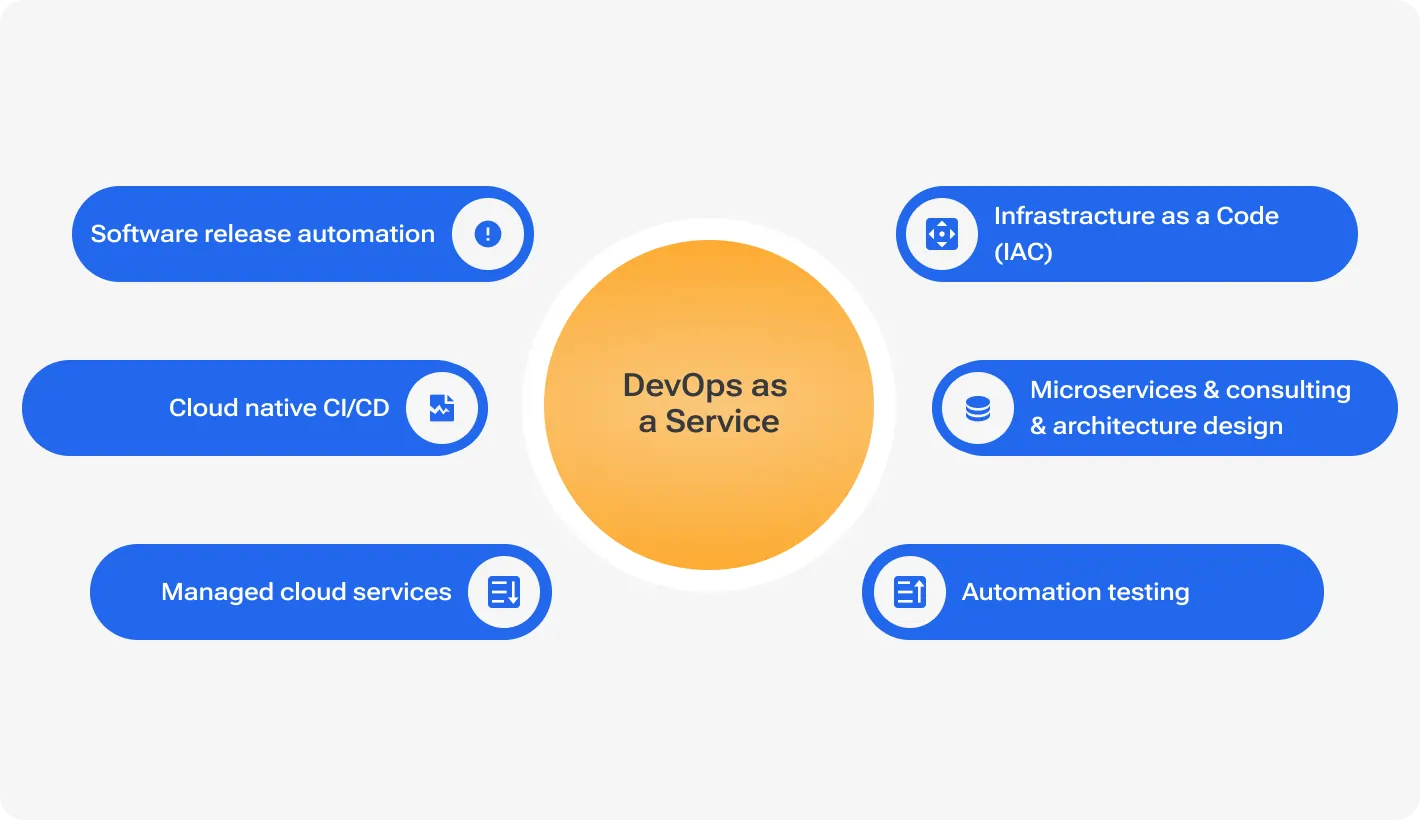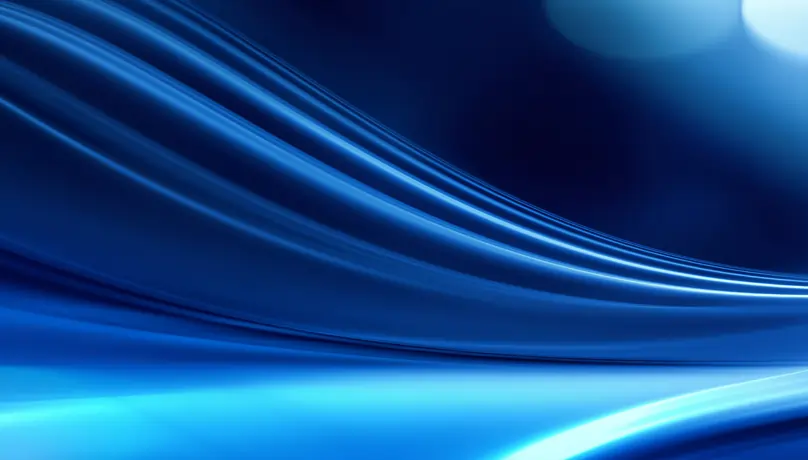If you want to reduce your software deployment time from days to minutes – then there is a solution — DevOps as a service. It is expected to grow fast, expanding from $10.35 billion in 2023 to $49.09 billion by 2030, with a compound annual growth rate (CAGR) of 24.9% between 2024 and 2030.
This cloud-based solution can be incorporated into the current IT ecosystem and does not cause any discomfort to the users. Thus, DaaS allows the development and operations teams to be integrated seamlessly into an organization’s software development process to reduce time and effort to release new software to the market. In addition, 48% of the questioned companies state that DevOps as a Service contributes to future business development. This means that with DevOps outsourcing services, companies can optimize the opportunities for integration, automation, and improvement to gain a competitive edge.
Embrace DevOps and reduce your time-to-market by 21%, elevating your business to new heights of success
Understanding DevOps as a service
DevOps is currently a hot topic in the tech industry. According to Harvard Business Analytics, 70% of respondents cite DevOps as a crucial factor for increasing speed to market, productivity, innovation, customer relevance, and service quality. With such rapid growth, it's crucial to understand what DevOps as a Service entails and how it can benefit your organization. DevOps as a Service is a model through which companies can get outsourcing DevOps solutions from a reliable third-party provider. First and foremost, it aims to connect the two main pillars of any software development organization, namely development and operation teams.
DaaS extends the collaboration to the cloud and makes it possible to have a real-time view of the activities within the SDLC. This makes it possible for organizations to embrace key measures like CD and CI that are used in the delivery of business value. There are other key differences from traditional DevOps, which we have gathered for your understanding:
Characteristic
Traditional DevOps
DevOps as a service (DaaS)
Requires significant upfront investment in hardware, software, and personnel
Cloud-based, on-demand access to platform and tools
Limited scalability, requires manual scaling
Scalable up or down to match changing business needs
Maintenance and upgrades require internal resources
Platform maintenance and upgrades are handled by the DaaS provider
Security measures require internal resources and expertise
Robust security measures provided by DaaS provider
Longer time-to-market due to the complexity of implementation
Faster time-to-market due to cloud-based, on-demand access
Higher risk due to internal implementation and maintenance responsibilities
Lower risk due to DevOps provider's maintenance and support responsibilities
Core components and functionalities of DaaS
DevOps outsourcing is the process that aims to optimize the software development and deployment processes as well as the operations. At the center of this strategy are 7 core services that are intertwined in the enhancement of efficiency, reliability, and integration. Now, let us briefly review each of these services.
Continuous integration (CI)
Consider CI as the last line of defense as far as quality is concerned. It enforces the procedure of updating code changes in the repository, which guarantees that every code change is inspected and approved.
Example tools: Jenkins, GitLab CI/CD, Travis CI.
Benefits: Early detection of bugs, improved code quality, reduced integration time.
A development team uses Continuous Integration to automate building and testing of their code, reducing the time spent on debugging by 50% and improving overall code quality.
Continuous delivery (CD)
CI is followed by CD, where the process of deployment is automated to make it even more efficient. This is beneficial for developers because they can easily publish code changes in the live and testing environments and be able to bring products to the market.
Example tools: Jenkins, Ansible, Docker, Kubernetes.
Benefits: Faster time-to-market, reduced deployment risk, increased customer satisfaction.
A company uses Continuous Delivery to automate the deployment of their mobile app, reducing deployment time from weeks to hours and increasing customer satisfaction ratings by 25%.
Infrastructure as code (IaC)
Infrastructure as Code changes the way how infrastructure is managed by making it as another code. This method helps maintain consistency and repeatability in the deployment of infrastructure and hence helps manage complicated systems.
Example tools: Terraform, AWS CloudFormation, Azure Resource Manager, Ansible.
Benefits: Version control of infrastructure, improved consistency, reduced errors, increased efficiency.
A company uses Infrastructure as Code to manage its cloud infrastructure, automating the creation of virtual machines, networks, and databases. This allows them to reproduce complex infrastructure environments in minutes, reducing deployment time by 75% and decreasing errors by 90%.
Monitoring and logging
DevOps is also concerned with monitoring application performance and documenting performance logs for analysis. This assists you in diagnosing potential concerns, analyzing the issues that may occur, or improving the efficiency of the system.
Example tools: Prometheus, Grafana, ELK Stack (Elasticsearch, Logstash, Kibana), New Relic.
Benefits: Real-time monitoring, issue detection, error tracking, performance optimization.
A company uses Monitoring and Logging to track its e-commerce website's performance, detecting slow response times and high error rates. By analyzing the logs and metrics, they identify a database query that is causing the issues and optimize it, resulting in a 30% increase in website performance and a 25% reduction in support requests.
Configuration management
It is the practice of managing and automating the configuration of the infrastructure elements to achieve uniformity and to enable the easy scaling up or down of the environment.
Example tools: Ansible, Puppet, Chef, SaltStack.
Benefits: Version control of configurations, automated deployment, easy scaling, reduced errors.
A company uses Configuration Management to automate the deployment of their web application to multiple environments. By writing a playbook with Ansible, they can easily configure the application's dependencies, databases, and services across different environments, ensuring consistency and reducing deployment time by 80%.
Automated testing
Automated testing frameworks and tools are very useful to check the integrity of code changes by executing tests on them. These are the unit test, integration test, and end-to-end test.
Example tools: Playwright, Selenium, Cypress.
Benefits: Faster testing, reduced errors, increased confidence in code changes
A company uses automated testing to ensure that their mobile app's new feature does not introduce any regressions. By running automated unit tests, integration tests, and end-to-end tests, they catch a critical bug that would have caused user data loss. As a result, they can resolve the issue before deploying the feature to production, saving them from potential reputational damage and user churn.
Security practices
Security is integral to DevOps. Incorporating security practices throughout the software development lifecycle—including code analysis, vulnerability scanning, and access control measures—ensures that your applications remain secure from the ground up.
Example tools: Snyk, SonarQube, OWASP ZAP.
Benefits: Early vulnerability detection, continuous security, compliance adherence.
A healthcare application integrates security tools to comply with regulations and protect sensitive patient data.
How DevOps as a service works
The DevOps model is a continuous cycle of seven stages that are linked together to produce quality software in a short time. Here's a closer look at each phase:
-
Plan: It all begins with the planning process. The development teams engage with the business units to gather the requirements and define features, to chart the course for the software application.
-
Develop: With a clear plan in place, development teams then move into the coding phase and build the software application with great detail. During this stage, DevOps Engineers hold a crucial position since they are involved in creating DevOps solutions, including the tools and technologies to use, manage, and maintain. Their work involves cooperating with the development team, which is responsible for creating software applications.
-
Test: Then, the software is tested to check if it fulfills the stated requirements and has no defects. This stage is headed by the QA/Testing Team, whose job is to test the software applications to form quality and reliable software.
-
Release: After the testing process is over, the software is compiled and sent to the operations team for deployment.
-
Deploy: The operation engineers then come in and set up the software in the production environment for use.
-
Operate: The operations team always wants it to be in the best shape possible and therefore, it makes the right adjustments and alterations from time to time.
-
Monitor and receive feedback: Last, continuous monitoring follows, where user feedback and key performance indicators are monitored to spot bottlenecks. This process of repeating helps in growth and improvement.
Every stage of the DevOps framework is crucial to the achievement of the overall objectives. This is why it is important to apply a professional toolset to control the outgoing working results and the outcome in accordance with the technical specifications. Some common tools and technologies used in DaaS include:
Version control systems: Git, Subversion (SVN), Mercurial, Code Climate, GitLab, JFrog, Npm, Kubernetes, Docker, GitHub, Sonatype, Visual Studio Team System, Subversion.
Continuous integration/continuous deployment (CI/CD) tools: Jenkins, Travis CI, CircleCI, Split, Buddybuild, Codeship, Teamcity, Shippable.
Containerization: Docker, Kubernetes.
Orchestration: Ansible, SaltStack.
Monitoring and Logging: Nagios, Prometheus, Grafana.
Collaboration tools: Slack, JIRA, Trello.
Configuration management: Puppet, Chef, Ansible, Google Cloud Platform, HashiCorp, Amazon, Microsoft Azure, Release, Deploy, Heroku, Rackspace, OpsGenie, VictorOps.
Through the employment of additional tools and following this approach as a continuous and repetitive process, organizations can attain faster time to market, higher customer satisfaction, and higher organizational agility.
Benefits of DevOps as a Service
DevOps has become a game changer in business management, as it provides a range of advantages that help organizations become more agile, efficient, and customer-oriented.
1. Increased flexibility
DevOps as a Service providers help businesses to follow a proper development process and, as a result, can easily change according to market conditions and customer requirements. DevOps makes it possible for product managers to provide high-quality products in the market in the shortest time possible, thus giving a competitive edge to the market.
2. Boost Performance
Thus, DevOps helps to minimize the time for issue resolution before and after the deployment as a result of concentrating on prevention. This results in a shorter time to recover from failures, less incidence of rollbacks and hence, enhanced system availability. Moreover, it provides:
50% reduction in time spent solving issues related to security;
22% decrease in the amount of experience and skills wasted on unproductive tasks;
24% increase in speed of recovery after critical failures.
3. Business optimization
The members of the DevOps team can perform everyday tasks and release the developers to do more valuable tasks. This automation helps the teams to be more effective, thus increasing productivity and decreasing the time that it takes to get a new product to the market.
4. Improved customer satisfaction
The objective of DevOps is to provide quality software with frequent releases that do not affect the business and do not lead to downtime. Therefore, DevOps promotes collaboration and multiple feedback mechanisms to guarantee the provision of the best product to the customers.
5. Continuous integration
This way, developers can contribute their code to the common repository several times a day, and fix the bugs that may appear. This approach minimizes the occurrence of defects and errors, and thus products that are delivered meet the customers’ expectations.
6. Continuous deployment
DevOps allows developers to release the code straight to production after testing it and thus make the end users exposed to the latest version of the product. This way, the customers are always sure to get the latest version of the software with the latest features and bug fixes.
7. Continuous improvement
Another crucial issue that is present in the process of software development is the possibility of making changes. DevOps’ adaptability and agility allow teams to change things without any hassle; thus, keeping businesses running and risks at a minimum.
8. Real-time feedback
It is crucial to be informed about the current state of affairs and the further course of action, so that the work of the team is coordinated and everyone knows what tasks are set and when. DevOps offers timely notifications of system failures, and thus, teams can solve problems and guarantee high-quality products.
Why you should outsource DevOps Services
This spreadsheet outlines the key reasons why outsourcing DevOps services can be a strategic advantage for organizations.
Area
Before DevOps
After DevOps
Lack of resources, including personnel, infrastructure, and budget.
Access to experienced professionals, scalable infrastructure, and cost-effective solutions.
Requires expertise in multiple areas, such as cloud computing, containerization, and automation.
Managed complexity with access to necessary skills and knowledge.
Limited capacity to scale up or down to meet changing business demands.
Ability to scale up or down as required for efficient and productive DevOps processes.
High maintenance expenses, diverting resources from core business activities.
Reduced need for internal investment in personnel, infrastructure, and training, resulting in significant cost savings.
Limited expertise to stay up-to-date with the latest DevOps technologies and best practices.
Ongoing training and expertise ensure that DevOps processes are always current and effective.
Key considerations when choosing a DevOps outsourcing partner
When deciding that you require outsourcing your DevOps needs or when pondering over whether to hire DevOps engineers, one must take time and research.
Step 1: Background check
How long has this company been operating? Is there anything that could be a sign of a future problem? Check their leadership and/or management structure to see if it is coherent and adequate.
Step 2: Leverage expertise
Next, tap into your partner's technological expertise. This will help you get the most out of your partnership.
Step 3: Inspect tech stack
Now, take a closer look at the technologies your potential partner uses. However, you should also look at the technologies that your potential partner employs. While they may work on different projects, they should have expertise in areas like:
Infrastructure management (Terraform, Ansible, CloudFormation (AWS), Azure Resource Manager (ARM)).
Programming languages (Python, Java, C++, Ruby, JavaScript).
Cloud platforms (OpenStack, AWS, Microsoft Azure, IBM Cloud, Google Cloud Platform).
Monitoring and logging tools (Splunk, ELK Stack, New Relic, Sumo logic).
CI/CD tools (Jenkins, GitLab CI/CD, Travis CI, CircleCI, TeamCity).
Data analytics tools (Datadog, Tableau, ELK Stack, MongoDB Atlas).
Step 4: Referrals check
Try to get recommendations from other people within the industry, or through social media groups.
Have other people encountered this company and have they had good things to say about it?
Is there any evidence of their work in the form of case studies or testimonials concerning their effectiveness with other clients like them?
Step 5: Case studies
Review examples of past projects and their case studies.
What problems were encountered, if any?
How did the company deal with them?
Did they do well in some particular areas and weak in some other areas?
Step 6: Expertise and certification of the vendor
Assess the company’s certification and focus sectors. Some of the things that you should consider are if their professionals hold:
CKA (Certified Kubernetes Administrator)
AWS (Amazon Web Services)
DOEF (DevOps Engineering Foundation)
LCFS (Linux Foundation Certified System Administrator)
You may also verify if they have certain skills or training that they possess that differentiate them from the rest.
Thus, performing a background check and analyzing these additional areas will help you prepare to identify a suitable DevOps outsourcing partner and contribute to the accomplishment of your objectives.
How to choose the right DevOps service provider?
Success stories
Today, DevOps is considered one of the main competitive advantages for companies of any size and in any field, as it accelerates the rate of innovation, optimizes spending, and enhances customer satisfaction. So below are the 4 companies that have adopted DevOps and got great results.
1. Amazon
Amazon has been one of the leading organizations in DevOps, as it kicked off its transformation to the cloud with the creation of Amazon Web Services (AWS) in 2010. This move allowed the company to increase or decrease the production by a single unit, thus conserving resources and improving the overall efficiency. Amazon has a continuous deployment process which is controlled by the internal system Apollo, through which the developers are free to push code to any server of their choice at any time of their choice. Thus, due to the emphasis on quality and risk management, the DevOps approach at Amazon has led to high results in terms of deployment frequency: out of one million deployments, only one causes an outage on the Amazon website.
2. Netflix
Netflix is one of the market leaders in the streaming services industry, and it is not a secret that the company is ahead of its competitors when it comes to DevOps. Netflix has adopted what can be described as a microservices architecture, whereby the IT operations are implemented on the cloud and comprise hundreds of microservices that allow developers to deploy web images without physically having to engage the IT operations team. The company has a custom-built, web-based stage that lets updated images be included into the organization’s structure with no problem. This transformation not only allowed the company to streamline its operations but also contributed to an extraordinary growth in its subscriber base, multiplying eightfold since 2008. Additionally, the volume of monthly streaming hours skyrocketed, increasing a staggering thousand times from December 2007 to December 2015.
3. Etsy
At Etsy, there were slow, painful deployments and numerous silos and uncoordinated teams that slowed down the process. Nevertheless, the company realized the need for this and started allowing developers to push their code in approximately 2009. This change allowed Etsy more control and manageability in terms of feature and update implementation and boosted its development process.
4. NASA
NASA’s Jet Propulsion Laboratory implemented DevOps in delivering real-time analysis of the data coming from the Mars Rover Curiosity that sends millions of data points each day. Thus, using the portable containerized data systems and tools for continuous deployment, the systems engineers and data scientists were able to create faster visualizations and algorithms for the data analysis. The availability of the AWS services and the scalable APIs made it easier to store and transfer the Big Data that was collected by the Curiosity rover.
These companies show that DevOps is not just another trend – it is a practical methodology that helps to achieve tangible goals and enhance the speed, quality, and efficiency of cooperation.
Conclusion
DevOps as a Service is a powerful solution for businesses that aim to revolutionize their software development and deployment strategies. According to that, outsourcing the DevOps to the reliable provider can bring the additional advantages and resources that are hardly possible to obtain in-house.
With DevOps as a Service, you'll enjoy the benefits of:
Frequent and fast deployment as well as iteration;
The main outcome is the enhancement of the cooperation and coordination between the development and operations teams.
Greater clarity as to what is going on in the development process;
Lower costs and greater effectiveness;
High-end equipment and technology that is modern and readily available to the organization.
DevOps is a powerful strategy to boost productivity and outpace competitors. Devico’s DevOps as a Service offers quick, seamless benefits tailored to your needs. By outsourcing to us, you can focus on growing your business while we handle infrastructure, management, and maintenance.
Ready to enhance your IT infrastructure's efficiency?







